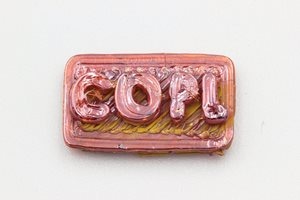Apr 19 2019
Chalcogenide glass—an exclusive material used for fabricating optical components that work at mid-infrared wavelengths—has been successfully 3D printed by researchers for the first time.
 Researchers demonstrated 3D printing of chalcogenide glass, which can be used to make optical components that operate at mid-infrared wavelengths. This 3D printed glass sample is 14 millimeters long. (Image credit: Steeve Morency, Université Laval)
Researchers demonstrated 3D printing of chalcogenide glass, which can be used to make optical components that operate at mid-infrared wavelengths. This 3D printed glass sample is 14 millimeters long. (Image credit: Steeve Morency, Université Laval)
This latest breakthrough to 3D print the chalcogenide glass can make it feasible to develop intricate optical fibers and glass components for the newest generation of affordable sensors, biomedical devices, and telecommunications components.
Researchers—Patrick Larochelle and his colleagues—from the Centre d’Optique, Photonique et Laser (COPL) at Université Laval in Canada, have successfully adapted a 3D printer, which is commercially available in the market, for glass extrusion. They have reported the results of the study in The Optical Society (OSA) journal, Optical Materials Express. The latest technique is built on the oft-used method of fused deposition modeling, which involves melting and subsequent extrusion of a plastic filament in a layer-by-layer fashion to produce intricate 3D objects.
3D printing of optical materials will pave the way for a new era of designing and combining materials to produce the photonic components and fibers of the future. This new method could potentially result in a breakthrough for efficient manufacturing of infrared optical components at a low cost.
Yannick Ledemi, Research Scientist, Centre d’Optique, Photonique et Laser (COPL), Université Laval
Ledemi is a member of the research team.
Printing glass
When compared to other kinds of glass, chalcogenide glass has a tendency to soften at a comparatively low temperature. Hence, to enable the extrusion of the chalcogenide glass, the researchers raised the highest extruding temperature of a commercially available 3D printer from about 260 °C to 330 °C. The team then created chalcogenide glass filaments whose dimensions were analogous to the commercially available plastic filaments that are often utilized with the 3D printer. Then, the printer was eventually programmed to produce a couple of samples having intricate dimensions and shapes.
Our approach is very well suited for soft chalcogenide glass, but alternative approaches are also being explored to print other types of glass. This could allow fabrication of components made of multiple materials. Glass could also be combined with polymers with specialized electro-conductive or optical properties to produce multi-functional 3D printed devices.
Yannick Ledemi, Research Scientist, Centre d’Optique, Photonique et Laser (COPL), Université Laval
In addition, 3D printing can prove handy for fabricating fiber preforms—a glass piece that is stretched into a fiber—using multiple materials or intricate geometries, or a mixture of both. After the design and fabrication techniques are perfected, 3D printing can be utilized for low-cost development of large quantities of fiber preforms or infrared glass components, stated the scientists.
3D printed chalcogenide-based components would be useful for infrared thermal imaging for defense and security applications. They would also enable sensors for pollutant monitoring, biomedicine and other applications where the infrared chemical signature of molecules is used for detection and diagnosis.
Yannick Ledemi, Research Scientist, Centre d’Optique, Photonique et Laser (COPL), Université Laval
Currently, the team is exploring ways to enhance the printer’s design so as to boost its performance and allow additive manufacturing of intricate components or parts composed of chalcogenide glass. Moreover, the researchers want to add novel extruders as this would allow polymers to be co-printed for developing multi-material components.
The study is part of the PROTEus (short for PRinting of exotic multi-maTErial fibers) project performed within the frame of the International Associated Laboratory ‘Lumière Matière Aquitaine Québec (LIA-LuMAQ). The PROTEus project brings together French and Canadian scientists to create new methods to utilize direct laser writing and additive manufacturing techniques so that various materials can be integrated to fabricate fiber-based photonic devices and components.